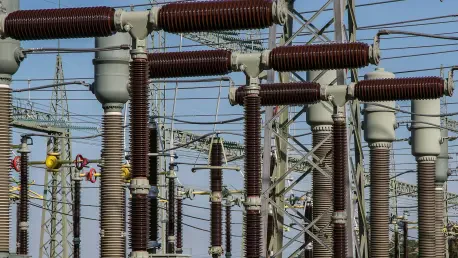The world is grappling with an energy crisis that threatens the very foundation of economic progress, as aging power grids struggle to keep pace with soaring demands and shifting paradigms, revealing a stark mismatch between outdated infrastructure and modern needs. Built decades ago for a simpler era of consistent and predictable electricity flows, these systems are now faltering under pressures they were never designed to handle. From catastrophic blackouts plunging entire nations into darkness to staggering financial losses in mere hours, the fragility of current infrastructure is undeniable. As societies push toward electrification, renewable energy, and technology-driven growth, a critical question looms: can the economy of the future thrive on technology rooted in the past? This exploration delves into the mounting challenges facing global power systems, the economic consequences of their failures, and the innovative solutions that could pave the way for resilience. The stakes are high, and the time to act is slipping away.
Unveiling a Global Infrastructure Crisis
The fragility of today’s power grids is becoming alarmingly evident through a series of high-profile failures across the globe. A devastating blackout in Chile left over 90% of its population without electricity, exposing the vulnerability of even well-established systems. Similarly, a 12-hour outage across Spain and Portugal resulted in a staggering $450 million in damages, illustrating how quickly disruptions can spiral into economic disasters. In the U.S., frequent emergency alerts signal dangerously low reserves and grid congestion, pushing systems beyond their limits. These events are not mere anomalies but symptoms of a broader issue: infrastructure designed for a bygone era is ill-equipped to handle modern energy needs. The increasing frequency and severity of such incidents serve as a wake-up call, highlighting the urgent need to address systemic weaknesses before they lead to even greater catastrophes.
Beyond individual events, the cumulative impact of grid failures paints a grim picture of global reliability. Each outage chips away at public confidence in energy systems while straining resources needed for recovery and repair. The reality is that many grids are operating at or beyond capacity, unable to absorb unexpected shocks like extreme weather or sudden spikes in demand. This chronic overextension jeopardizes not just daily life but also the stability of entire economies dependent on uninterrupted power. Governments and utilities face mounting pressure to act, yet the scale of the challenge often delays meaningful progress. The longer these issues persist, the more they threaten to undermine critical services and infrastructure, from hospitals to industrial hubs. Addressing this crisis requires a fundamental shift in how energy systems are designed and maintained, prioritizing resilience over short-term fixes.
Navigating a Transformed Energy Horizon
The energy landscape has undergone a profound transformation, placing unprecedented strain on outdated grid systems. The electrification of transportation and buildings, coupled with the explosive growth of power-intensive technologies like artificial intelligence and data centers, has dramatically altered consumption patterns. Add to that the increasing frequency of extreme weather events, which disrupt supply and spike demand unpredictably, and the result is a grid pushed to its breaking point. Traditional infrastructure, built for a one-way flow of electricity from centralized plants, struggles to adapt to these dynamic shifts. This mismatch between capability and requirement reveals a critical flaw: systems rooted in the past cannot support the complexities of today’s energy demands.
Compounding the issue is the rapid integration of renewable energy sources such as solar and wind into the power mix. While essential for sustainability, these sources introduce intermittency and unpredictability, as their output depends on weather conditions rather than consistent generation. Grids designed for steady, fossil-fuel-based production falter under this variability, unable to balance supply and demand effectively. The result is a heightened risk of instability, with potential blackouts looming whenever renewable output dips or demand surges. This evolving reality demands a rethinking of grid architecture, moving toward systems capable of storing and distributing energy flexibly. Without such adaptation, the transition to cleaner energy risks stalling, trapped by the limitations of infrastructure never meant to handle such a diverse and fluctuating energy portfolio.
Economic Perils of Power Instability
The economic consequences of an unreliable power grid are both immediate and far-reaching, striking at the heart of industrial and societal progress. Outages disrupt critical industries, bringing manufacturing lines to a halt and causing significant losses in productivity. Emerging sectors, such as technology and innovation hubs, are particularly vulnerable, as they rely heavily on consistent electricity to power data centers and advanced systems. The financial impact of these disruptions is staggering, with billions lost annually to blackouts and reliability issues. Such instability not only hampers current operations but also deters investment in future growth, as businesses hesitate to expand in regions with uncertain power supplies. The ripple effect touches every corner of the economy, underscoring the urgent need for modernization.
Moreover, the cost of inaction extends beyond direct financial losses to long-term economic stagnation. A faltering grid undermines ambitious plans for electrification and sustainable development, key drivers of future prosperity. Communities suffer as well, with power disruptions affecting essential services like healthcare and education, further eroding quality of life. The inability to guarantee a stable energy supply threatens to derail national and global goals for innovation and carbon reduction. Grid modernization, therefore, emerges as more than a technical necessity—it is an economic imperative. Investing in robust infrastructure now can prevent the compounding costs of repeated failures, safeguarding both current livelihoods and future opportunities. The path forward requires prioritizing energy reliability as a cornerstone of economic policy, ensuring that progress is not held hostage by outdated systems.
Forging a Path to Energy Resilience
Despite the daunting challenges, pathways to a more resilient energy future are emerging with promising clarity. The power grid must transform from a static delivery mechanism into a dynamic platform capable of balancing fluctuating supply and demand with precision. Long-duration energy storage (LDES) stands out as a critical solution, offering the ability to store excess energy during periods of low demand and release it during peaks or renewable lulls. Hydrostor’s Advanced Compressed Air Energy Storage (A-CAES) technology exemplifies this innovation, providing scalable storage with capacities up to 500 MW for 8-24 hours. Projects in Australia’s Silver City and California’s Willow Rock demonstrate its real-world impact, replacing unreliable transmission lines and supporting decarbonization goals. Such advancements signal a shift toward grids that can adapt to modern needs without sacrificing stability.
The broader benefits of technologies like A-CAES extend into economic and social spheres, reinforcing their value as a cornerstone of grid modernization. Beyond ensuring reliability, these projects stimulate local economies through job creation and investment, fostering community support for energy transitions. Their durability—often exceeding 50 years—and minimal land requirements make them practical for widespread adoption, even in constrained environments. By integrating LDES into grid planning, utilities can mitigate the risks of intermittency associated with renewables while meeting rising demand from electrification and technology growth. This approach not only addresses immediate vulnerabilities but also lays the groundwork for a sustainable energy ecosystem. Reflecting on past failures, it’s evident that bold steps taken in previous years to pilot such solutions have yielded tangible results, proving that innovation can outpace obsolescence if prioritized.









